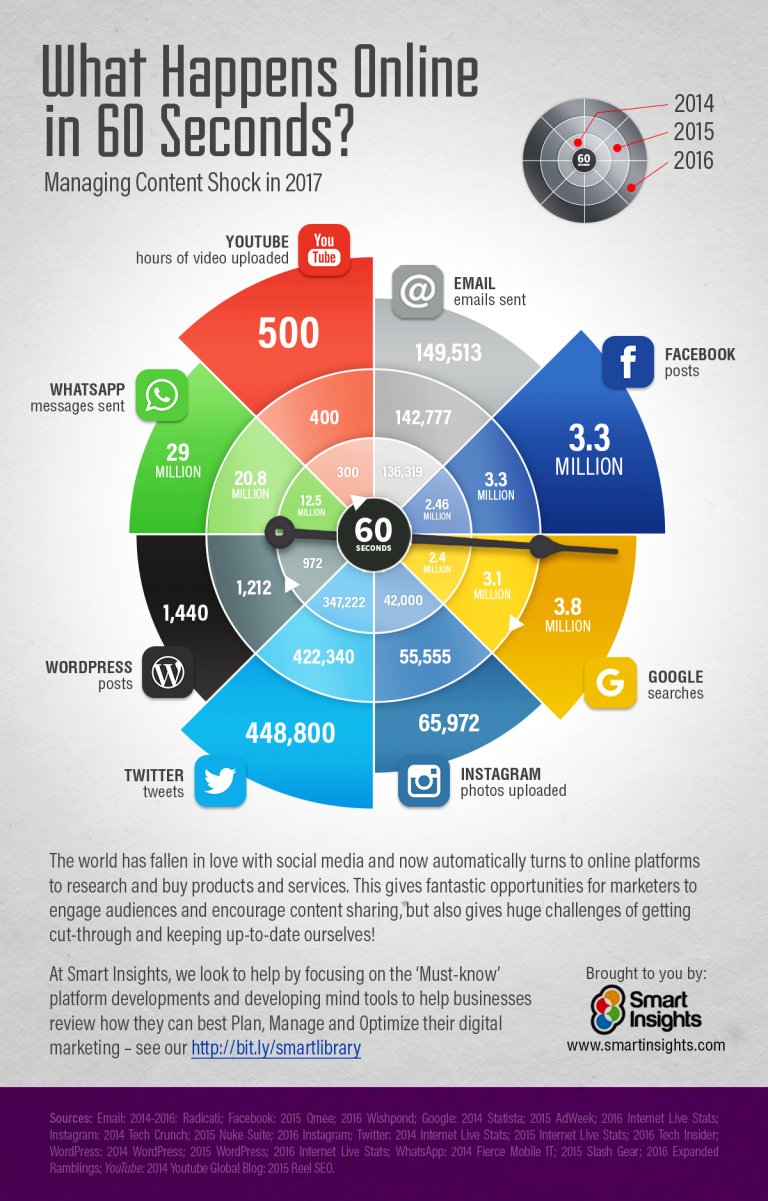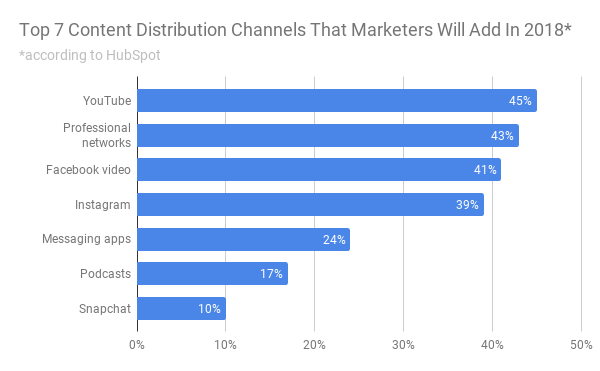Content marketing has been on the rise for the past decade—and it's showing no signs of slowing down any time soon. As a marketing strategy, content is here to stay. However, producing content alone doesn't guarantee your business success.
For instance, 75% of online articles don't earn any external backlinks, and 50% get two or fewer interactions on Facebook, a study by Moz found. That's not a surprise. Content supply has overtaken content demand, resulting in a phenomenon referred to as content shock—and a fierce fight for users' attention.
The following infographic by Smart Insights demonstrates the staggering amount of content that's produced every minute (and this was in 2017!):

Considering that so much content is being produced, what's the solution to making content marketing work for you today?
According to Moz, Kissmetrics, and Neil Patel, the answer is content distribution.
What is content distribution?
Content distribution refers to the process of promoting content across paid or free channels in order to increase content reach, boost engagement, and grow organic traffic.
These are some of the most common content distribution channels:
- Social media (e.g., Facebook, Twitter, Instagram, YouTube)
- Search ads (e.g., Google AdWords)
- Professional networks (e.g., LinkedIn, Xing)
- Forums (e.g., Reddit, GrowthHackers.com)
- Blogs
- Media (e.g., newspapers, journals, podcasts)
- Corporate channels (e.g., newsletters, apps, your own website)
Why should you invest in content distribution?
Producing and publishing content won't get you anywhere on its own in this era of content shock. Carefully managed content distribution is how you can overcome the content-shock challenge and make sure your content doesn't get buried deep in Google's search engine results pages.
Here are some more reasons you should invest more into the distribution of your content:
- It will bring extra organic traffic to your site from new channels.
- It will help you grow your audience on social media.
- It will increase the return on your content marketing investment.
- It will support indirect link-building, which benefits your article and entire domain.
"Social media is the new SEO," according to Neil Patel.
Where and how should you distribute content?

HubSpot's State of Inbound 2018 survey
Marketers can pick from a wide range of distribution channels when looking to give their content some promotion. However, the optimal choice ultimately depends on your target audience. So let's take a closer look at the various content distribution channels and how to use them to give your content exposure.
Social Media
Promote content actively by publishing your articles on social media. Data gathered by Buffer found that reposting a blog article multiple times on social media bears fruits, with every repost recouping 75% of engagement, on average. To increase engagement and further drive the distribution of your articles and posts, tag people and organizations mentioned in them.
Turn your articles into videos and publish them on YouTube to get additional keyword results on Google and to reach a new audience. Two of the top three distribution channels to focus on are YouTube and Facebook Video, according to HubSpot's State of Inbound 2018 survey. Video is a way to stand out in a market saturated with written content. (Bonus tip: tools like Lumen5 are available for free and can help you generate videos based on your blog articles with ease by leveraging AI.)
Add share buttons to your blog so that users can distribute posts with one click. This might also help to make your article more popular as articles that are shared 100+ times can build social proof, attracting users who haven't yet read your insights.
You can also promote your content through ads on Facebook, Instagram, and Twitter. However, you should be cautious with this strategy; you would likely get a higher ROI by promoting your product landing pages directly, instead of linking to your blog or other content.
Search Ads
Promote your content via ads on Google, Bing, and other search engines. As with paid social media ads, keep in mind that it might make more sense to promote your products instead of your article or other content, if you're looking to directly boost sales and ROI.
Professional Networks
Publish your content on professional networks to reach a more mature or business-minded audience. LinkedIn, for global audiences, and Xing, for German speaking countries, work really well if you're in the B2B market. Simply post your article through your corporate channel to promote your brand directly.
Position yourself as a thought leader by sharing your ideas on LinkedIn Pulse.
Join relevant LinkedIn Groups and share your content there. Be careful not to post any commercial messages if they aren't allowed within specific groups.
Forums
Answer questions and contribute on sites like Reddit, and post on niche forums for your industry with excerpts from your content. For example, as a marketing agency, we love to use the GrowthHackers community forum to spread our content.
Blogs
Reach out to relevant bloggers and ask them to republish, mention, or cite your content. This approach works best if you have created an insightful study or you are presenting an interesting infographic. If it's an article, be careful to not offer bloggers duplicate content.
Publish your articles on free blogging sites, like Medium, so you can reach new audiences.
Media
Contact media through PR campaigns to help promote your content and secure high-quality backlinks. Make sure your content is unique, new, and insightful, otherwise you'll simply be wasting everybody's time: You won't see results, and you risk jeopardizing potential relationships with media groups.
Corporate Channels
Include your content in your corporate newsletter—an easy way to get your content in front of people for free and quickly. Just ensure your content is relevant and useful to your audience.
Repurpose your content by turning your articles into videos, webinars, e-books, lead magnets, etc. that you can share in other sections of your website or app.
* * *
Content distribution is becoming key as the fight for attention online intensifies. Marketers who want to increase the ROI of their content production should look to promote their content on as many relevant channels as possible.




